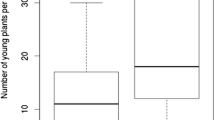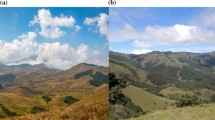Abstract
Invasive mammals can fundamentally alter native plant communities, especially on isolated islands where plants evolved without them. The globally invasive feral pig (Sus scrofa) can be particularly destructive to native plant communities. Tree ferns are an important understory component in many forests facilitating the establishment of a variety of species. However, the extent and effects of feral pig damage to tree ferns, and associated impacts on plant community regeneration, are largely unknown. We quantified the effect that feral pig damage has on tree fern growth, survival, and epiphytic woody seedling abundance over 1 year on 438 randomly selected tree ferns of three endemic species (Cibotium chamissoi, Cibotium glaucum, and Cibotium menziesii) in a Hawaiian montane wet forest with high tree fern and feral pig densities. Across all tree fern species, feral pigs damaged 13 % of individuals over 1 year. Compared with undamaged tree ferns, moderately- to heavily-damaged individuals had decreases of 4 to 27 % in trunk length increment and lost tenfold more fronds. Tree fern angle (standing, leaning, prone, or semi-prone) and woody seedling abundance co-varied with feral pig damage. Specifically, damaged tree ferns were more often prone or semi-prone and supported more seedlings, but also had annual mortality up to 34 % higher than undamaged tree ferns. Overall, feral pig damage had substantial negative effects on tree ferns by reducing growth and survival. Given the importance of tree ferns as regeneration sites for a variety of native plants, feral pig damage to tree ferns will likely alter future forest composition and structure. Specifically, feral pig damage to tree ferns reduces potential establishment sites for species that either regenerate preferentially as epiphytes or are currently restricted to epiphytic establishment due to ground rooting by feral pigs.






Similar content being viewed by others
References
Tropicos org Missouri Botanical Garden (2013) http://www.tropicos.org/. Accessed Feb 13, 2013
Agresti A, Wackerly D (1977) Some exact conditional tests of independence for R × C cross-classification tables. Psychometrika 42(1):111–125
Anderson SJ, Stone CP (1993) Snaring to control feral pigs (Sus scrofa) in a remote Hawaiian rain forest. Biol Conserv 63(3):195–201
Arcand N, Kagawa AK, Sack L, Giambelluca TW (2008) Scaling of frond form in Hawaiian tree fern Cibotium glaucum: compliance with global trends and application for field estimation. Biotropica 40(6):686–691
Baker JK (1979) The feral pig in Hawaii Volcanoes National Park. In: Proceedings of the first conference on Scientific Research in the National Parks, New Orleans, Louisiana, USA, pp 365–367
Barrios-Garcia M, Ballari S (2012) Impact of wild boar (Sus scrofa) in its introduced and native range: a review. Biol Invasions 14:2283–2300
Bellingham P, Richardson S (2006) Tree seedling growth and survival over 6 years across different micro sites in a temperate rain forest. Can J For Res 36(4):910–918
Buck MG (1982) Hawaiian treefern harvesting affects forest regeneration and plant succession. Research Note. USDA Forest Service Pacific Southwest Forest and Range Experiment Station, Berkeley, CA, USA
Byers CR, Steinhorst RK, Krausman PR (1984) Clarification of a technique for analysis of utilization-availability data. J Wildl Manag 48(3):1050–1053
Campbell TA, Long DB (2009) Feral swine damage and damage management in forested ecosystems. For Ecol Manag 257(12):2319–2326
Cole RJ, Litton CM, Koontz MJ, Loh RK (2012) Vegetation recovery 16 years after feral pig removal from a wet Hawaiian forest. Biotropica 44(1):463–471
Coomes DA, Allen RB, Forsyth DM, Lee WG (2003) Factors preventing the recovery of New Zealand forests following control of invasive deer. Conserv Biol 17(2):450–459
Drake DR, Mueller-Dombois D (1993) Population development of rain-forest trees on a chrono sequence of Hawaiian lava flows. Ecology 74(4):1012–1019
Durand LZ, Goldstein G (2001) Growth, leaf characteristics, and spore production in native and invasive tree ferns in Hawaii. Am Fern J 91(1):25–35
Fisher RA (1922) On the interpretation of χ2 from contingency tables, and the calculation of P. J R Stat Soc 85(1):87–94
Friday JB, Scowcroft PG, Ares A (2008) Responses of native and invasive plant species to selective logging in an Acacia koa-Metrosideros polymorpha forest in Hawai’i. Appl Veg Sci 11(4):471–482
Gaxiola A, Burrows LE, Coomes DA (2008) Tree fern trunks facilitate seedling regeneration in a productive lowland temperate rain forest. Oecologia 155(2):325–335
Giambelluca TW, Chen Q, Frazier AG, Price JP, Chen YL, Chu PS, Eischeid JK, Delparte DM (2013) Online rainfall Atlas of Hawai’i. Bull Am Meteorol Soc 94:313–316
Giffin J (1978) Ecology of the feral pig on the island of Hawaii. Department of Land and Natural Resources, Division of Fish and Game, State of Hawaii
Heinken T, Schmidt M, Von Oheimb G, Kriebitzsch WU, Ellenberg H (2006) Soil seed banks near rubbing trees indicate dispersal of plant species into forests by wild boar. Basic Appl Ecol 7(1):31–44
Hess SC, Jeffrey J, Ball DL, Babich L, Unit HCS (2006) Efficacy of feral pig removals at Hakalau Forest National Wildlife Refuge. Trans West Sect Wildl Soc 42:53–67
Holdridge LR (1947) Determination of world plant formations from simple climate data. Science 105:367–368
Hone J (2002) Feral pigs in Namadgi National Park, Australia: dynamics, impacts and management. Biol Conserv 105(2):231–242
Ickes K, Paciorek CJ, Thomas SC (2005) Impacts of nest construction by native pigs (Sus scrofa) on lowland Malaysian rain forest saplings. Ecology 86(6):1540–1547
Inman-Narahari F, Ostertag R, Cordell S, Giardina CP, Nelson-Kaula K, Sack L (2013) Seedling recruitment factors in low-diversity Hawaiian wet forest: towards global comparisons among tropical forests. Ecosphere 4 (2):art24
Iwashita DK (2012) Role of coarse woody debris in carbon storage and seedling distribution in Hawaiian montane wet forests. M.S. Thesis, University of Hawaii at Manoa, Honolulu, HI, USA
Kellner JR, Asner GP (2009) Convergent structural responses of tropical forests to diverse disturbance regimes. Ecol Lett 12(9):9
Maguire LA (2004) What can decision analysis do for invasive species management? Risk Anal 24(4):859–868
Mayer JJ, Nelson EA, Wike LD (2000) Selective depredation of planted hardwood seedlings by wild pigs in a wetland restoration area. Ecol Eng 15:S79–S85
Nogueira-Filho S, Nogueira S, Fragoso J (2009) Ecological impacts of feral pigs in the Hawaiian Islands. Biodivers Conserv 18(14):3677–3683
Nuñez MA, Bailey JK, Schweitzer JA (2010) Population, community and ecosystem effects of exotic herbivores: a growing global concern. Biol Invasions 12(2):297–301
O’Brien P (1987) Socio-economic and biological impact of the feral pig in New South Wales: an overview and alternative management plan. Rangel J 9(2):96–101
Ott RL, Longnecker M (2001) An introduction to statistical methods and data analysis, 5th edn. Duxbury Pacific Grove, CA
Pimentel D, Lach L, Zuniga R, Morrison D (2000) Environmental and economic costs of nonindigenous species in the United States. Bioscience 50(1):53–65
Scowcroft P (1992) Role of decaying logs and other organic seedbeds in natural regeneration of Hawaiian forest species on abandoned montane pasture. Gen Tech Rep PSW-129. USDA Forest Service, Pacific Southwest Research Station, Albany, California, USA
Spear D, Chown SL (2009) Non-indigenous ungulates as a threat to biodiversity. J Zool 279(1):1–17
R Development Core Team (2012) R: a language and environment for statistical computing. R Foundation for Statistical Computing, Vienna, Austria. http://www.R-project.org
Thomson C, Challies C (1988) Diet of feral pigs in the podocarp-tawa forests of the Urewera ranges. N Z Journal of Ecol 11:73–78
Vitousek PM (1990) Biological invasions and ecosystem processes: towards an integration of population biology and ecosystem studies. Oikos 57(1):7–13
Walker LR, Aplet GH (1994) Growth and fertilization responses of Hawaiian tree ferns. Biotropica 26(4):378–383
Weller SG, Cabin RJ, Lorence DH, Perlman S, Wood K, Flynn T, Sakai AK (2011) Alien plant invasions, introduced ungulates, and alternative states in a mesic forest in Hawai’i. Restor Ecol 19(5):671–680
Acknowledgments
We thank the Pacific Internship Programs for Exploring Sciences (PIPES), especially Sharon Ziegler-Chong, Moana Ulu Ching, and Noelani Puniwai for their educational tools and support, and their partner agencies including the Kamehameha Schools ‘Aina Ulu Program, the National Science Foundation, the USFWS, and the USDA Forest Service IPIF. We thank the USDA Forest Service and State of Hawai‘i Department of Land and Natural Resources—Division of Forestry and Wildlife for access to the Hawai’i Experimental Tropical Forest. We thank Shane Hiraoka and Heather Franklin for field assistance, along with numerous interns and staff that helped to establish the Laupāhoehoe HIPPNET plot. Financial support was provided by National Science Foundation-EPSCoR (Grant No. 0554657 to J. Gaines), and the College of Tropical Agriculture and Human Resources at the University of Hawai‘i at Mānoa via the USDA National Institute of Food and Agriculture, Hatch (HAW00132-H to C.M. Litton) and Tropical and Subtropical Agriculture Research (2009-34135-20101 to C.M. Litton) Programs. We thank two anonymous reviewers for thoughtful comments on previous versions.
Author information
Authors and Affiliations
Corresponding author
Electronic supplementary material
Below is the link to the electronic supplementary material.
Rights and permissions
About this article
Cite this article
Murphy, M.J., Inman-Narahari, F., Ostertag, R. et al. Invasive feral pigs impact native tree ferns and woody seedlings in Hawaiian forest. Biol Invasions 16, 63–71 (2014). https://doi.org/10.1007/s10530-013-0503-2
Received:
Accepted:
Published:
Issue Date:
DOI: https://doi.org/10.1007/s10530-013-0503-2




